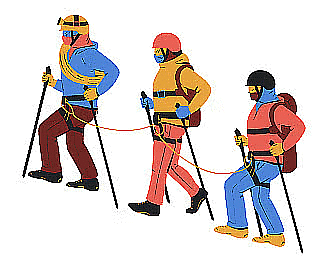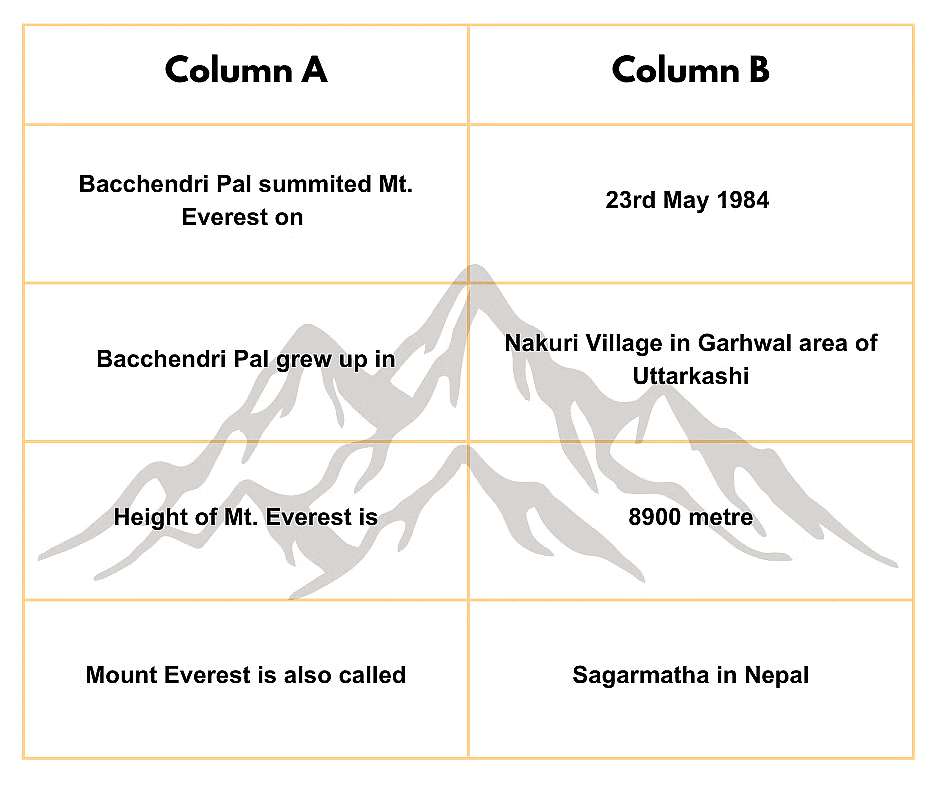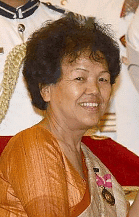Up You Go! - 1 Class 5 Worksheet EVS Chapter 9
Q1: Fill in the blanks
(i) _______________________ was the director of the adventure course.
(ii) Sangeeta had ____________ on her feet.
(iii) Sangeeta was made the ____________ of group number 7.
(iv) The rope was tightly fixed to ____________ or ____________ on both sides.
(v) Tekla village was at a height of ____________ metres. (vi) They saw fruits and vegetables growing in the ____________ fields.
(vi) They saw fruits and vegetables growing in the ____________ fields.
(vii) Khondonbi spoke only ____________ language.
(viii) They all made a chulha with ____________ and ____________.
(ix) The height of the Mt. Everest is about ____________ metres.
(x) The Mt. Everest is called ____________ in Nepal.
Ans:
(i) Brigadier Gyan Singh
(ii) Blisters
(iii) Leader
(iv) Pegs, pitons
(v) 1600
(vi) Step
(vii) Mizo
(viii) Firewood, stones
(ix) 8900
(x) Sagarmatha
Q2: Match this column
Ans:

Q3: True and False
(i) There is a campfire on the first day of camp.(ii) A group walks ahead of the group.
(iii) There is no discipline in a camp.
(iv) Bachendripal was the first Indian woman to go on the moon.
(v) There are no medical check-ups in a camp.
(vi) We feel happy on finishing a task.
(vii) While rock climbing, the body should be kept an angle of 450.
(viii) It is difficult to walk on the snow.
Ans:
(i) False
(ii) True
(iii) False
(iv) False
(v) False
(vi) True
(vii) False
(viii) True
Q4: Multiple Choice Questions
(i) What is the most important responsibility of a leader?
(a) To punish whoever has made a mistake.
(b) To own responsibility even when someone else has made a mistake.
(c) To remain in front of the group.
(d) To keep everyone under strict command.
Ans: (b)
(ii) Why do we need extra energy in the mountains?
(a) During mountaineering we have to go up. Thus we spend energy faster.
(b) Due to less air we breathe faster and so need extra energy.
(c) The climate of mountains is generally cold. Our body needs extra energy to keep itself warm.
(d) Food is digested faster in mountains. So we need extra energy.
Ans: (a)
(iii) Why was a drain dug around the tent?
(a) Water would flow down the tent’s roof into the drain if it rains.
(b) To keep away wild animals.
(c) To collect waste water.
(d) To make the surroundings more beautiful.
Ans: (a)
Q5: Short Answer Type Questions
(i) Where is Nehru Institute of Mountaineering located?
Ans: Nehru Institute of Mountaineering is situated on a hilltop 4 km away from the main market of Uttarkashi.
(ii) Who is the first Indian woman to climb the Mt. Everest?
Ans: Bachendri Pal is the first Indian woman to climb Mt. Everest.
(iii) Who was the guide of Bachendripal?
Ans: Brigadier Gyan Singh was the guide of Bachendri Pal.
(iv) How many minutes did Bachendripal spend on the peak of Mt. Everest?
Ans: Bachendripal spent 43 minutes on the peak of Mt. Everest
(v) Who had come to meet the Brigadier?
Ans: Bachendripal came to meet the Brigadier.
(vi) Who is Bachendripal?
Ans: Bachendri Pal, an Indian mountaineer who in 1984 became the first Indian woman to reach the summit of Mount Everest.
(vii) What is rapling (rappelling)?
Ans: Rappelling is an adventure activity that involves coming down a rock face/ artificial climbing wall with the help of ropes and equipment.
(viii) What is the correct way of rock climbing? Ans: For rock climbing wear specially made gloves and shoes which can increase friction due to their rough surface. Due to an increase in friction, proper grip is obtained with the rocks so that we can easily climb the rocks without the danger of falling.
Ans: For rock climbing wear specially made gloves and shoes which can increase friction due to their rough surface. Due to an increase in friction, proper grip is obtained with the rocks so that we can easily climb the rocks without the danger of falling.
(ix) Identify the person in the picture who is the first Indian woman to climb the Mt. Everest. Ans: Bachendri Pal
Ans: Bachendri Pal
Q6: Long Answer Type Questions
(i) Who had all gone for the mountaineering camp?
Ans: There were 20 teachers from Kendriya Vidyalaya and the other women from the banks
(ii) Who were the members of group number 7?
Ans: Group 7 included girls from Assam, Manipur, Mizoram, Meghalaya, and Nagaland and a teacher from Kendriya Vidyalaya.
(iii) What were the things there in a rucksack?
Ans: Rucksacks had all the things that they may need - food packets, water bottle, rope, hook, plastic sheet, diary, torch, towel, soap, windcheater, whistle, glucose, jaggery, channa, and some other snacks.
(iv) Why were double-layered plastic sheets used for the tent on the ground?
Ans: Thick, double-layered plastic sheets may be used as the base for a tent, for three main reasons – to prevent dampness and wetness from seeping in, for insulation from the cold and to provide some cushioning effect for the occupants inside the tent.
|
37 videos|244 docs|41 tests
|
FAQs on Up You Go! - 1 Class 5 Worksheet EVS Chapter 9
| 1. What is the main theme of the article "Up You Go!"? |  |
| 2. Who is the target audience for the article "Up You Go!"? |  |
| 3. What practical tips does the article provide for achieving success? |  |
| 4. How does the article suggest dealing with setbacks? |  |
| 5. Can the insights from "Up You Go!" be applied in everyday life? |  |






















